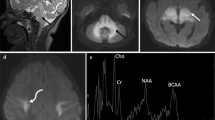Abstract
Objectives
Developmental delay is a common problem in paediatric practice and many children with developmental delay are referred for MR imaging. Our study was performed as part of a continuing audit process to optimise our MR protocol and case selection.
Materials and methods
We performed MR imaging and spectroscopy protocol on 157 children with developmental delay. We analysed the effect of these interventions by looking at the overall detection rate of relevant pathology and in particular subgroups of the children.
Results
71% of the children had normal MR imaging, 10% had non-specific findings and 19% had specific abnormalities on MR imaging. The overall risk of having a specific structural abnormality with isolated developmental was 7.5% but if other neurological symptoms/signs were present the risk was 28%. Two children had abnormal spectroscopic findings, one with tuberous sclerosis and the other with absent brain creatine.
Conclusion
Case selection for MR imaging is important in children with developmental delay. The best strategies for selecting children for MR are either; not performing MR with developmental delay in one domain only or performing MR with developmental delay in three or four domains or if there are other neurological features.







Similar content being viewed by others
References
Drillien CM, Pickering RM, Drummond MB (1988) Predictive value of screening for difficult areas of development. Dev Med Child Neurol 30:294–305
Kjos BO, Umansky R, Barkovich AJ (1990) Brain MR imaging in children with developmental retardation of unknown cause: results in 76 cases. Am J Neuroradiol 11:1035–1040
Hart AR, Batty R, Widjaja E, Rigby AS, Connolly DJA, Baxter PS, Griffiths PD (2010) Magnetic Resonance Imaging in children with global developmental delay—a retrospective case note review. J Pediatr Neurol. doi:10.3233/JPN20100428
Bouhadiba Z, Dacher J, Monroc M, Vanhulle C, Menard JF, Kalifa G (2000) MRI of the brain in the evaluation of children with developmental delay. J Radiol 81:870–873
Verbruggen KT, Meiners LC, Sijens PE, Lunsing RJ, van Spronsen FJ, Brouwer OF (2009) Magnetic resonance imaging and proton magnetic resonance spectroscopy of the brain in the diagnostic evaluation of developmental delay. Eur J Paediatr Neurol 13:181–190
Curry CJ, Stevenson RE, Aughton D, Byrne J, Carey JC, Cassidy S et al (1997) Evaluation of mental retardation: recommendations of a consensus conference. Am J Med Genet 72:468–477
Shevell M, Ashwal S, Donley D, Flint J, Gingold M, Hirtz D et al (2003) Practice parameter: evaluation of the child with global developmental delay: report of the Quality Standards Subcommittee of the American Academy of Neurology and The Practice Committee of the Child Neurology Society. Neurology 60:367–80
Mukonoweshuro W, Wilkinson ID, Griffiths PD (2001) Proton MR spectroscopy of cortical tubers in adults with Tuberous sclerosis complex. AJNR 22:1920–25
Widjaja E, Griffiths PD, Wilkinson ID (2003) MR Spectroscopy of polymicrogyria and heterotopia. AJNR 24:2077–2081
Barkovich AJ (2007) Kernicterus. In: Barkovich AJ (ed) Paediatric neuroradiology. Amirsys, Salt Lake City, pp 118–119
Bianchi MC, Tosetti M, Battini R, Leuzzi V, Alessandri MG et al (2007) Treatment monitoring of brain creatine deficiency syndromes: a 1H- and 31P-MR spectroscopy study. AJNR 28:548–554
Martin E, Keller M, Ritter S, Largo RH, Thiel T, Loenneker T (2005) Contribution of proton MR spectroscopy to the evaluation of children with unexplained developmental delay. Pediatr Res 58:754–760
Kosucu P, Erdemli S, Sonmez M, Kul S, Aksoy A (2010) MR spectroscopic evaluation of psychomotor delay of unknown cause in children. AJR 194:1110–1115
Filippi CG, Ulug AM, Deck MD, Rd Z, Heier LA (2002) Developmental delay in children: assessment with proton MR spectroscopy. AJNR 23:882–888
Fayed N, Morales H, Modrego PJ, Munoz-Mingarro J (2006) White matter proton MR spectroscopy in children with isolated developmental delay: does it mean delayed myelination? Acad Radiol 13:229–235
Maricich SM, Azizi P, Jones JY, Morriss MC, Hunter JV, Smith EO, Miller G (2007) Myelination as assessed by conventional MR imaging is normal in young children with idiopathic developmental delay. AJNR 28:1602–1605
Author information
Authors and Affiliations
Corresponding author
Rights and permissions
About this article
Cite this article
Griffiths, P.D., Batty, R., Warren, D. et al. The use of MR imaging and spectroscopy of the brain in children investigated for developmental delay: What is the most appropriate imaging strategy?. Eur Radiol 21, 1820–1830 (2011). https://doi.org/10.1007/s00330-011-2144-0
Received:
Accepted:
Published:
Issue Date:
DOI: https://doi.org/10.1007/s00330-011-2144-0




